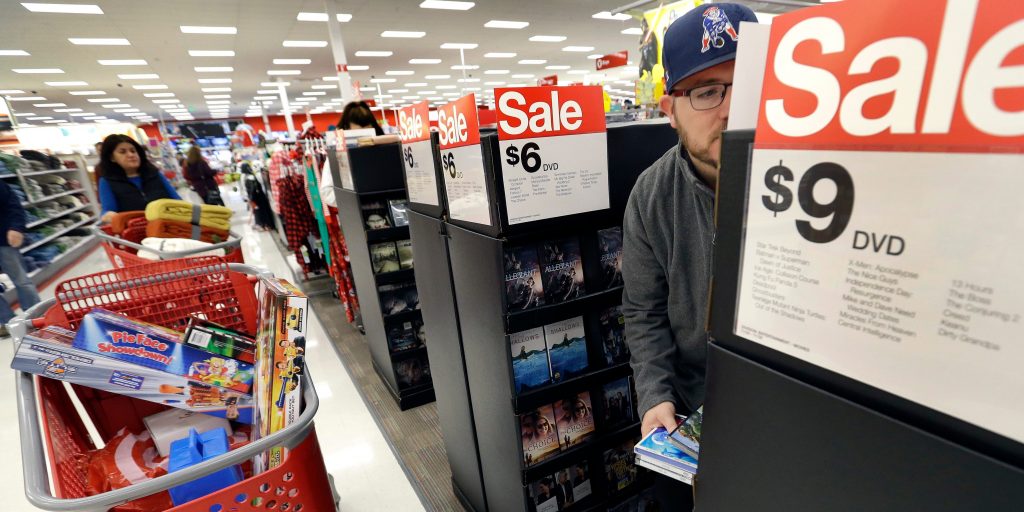- Americans are moving their spending from goods to services as the economy normalizes.
- The shift is keeping the recovery alive, as consumer spending counts for two-thirds of GDP.
- Yet the transition is a risky one, as any shock can cut overall spending and threaten a downturn.
After more than a year of stronger-than-usual spending, Americans are changing it up. That's not necessarily a bad thing.
The spending spree that lifted the economy from the coronavirus recession is petering out. Spending at retailers and restaurants was flat through July, slowing from the 0.8% gain seen the month prior, the Census Bureau said Wednesday. That came in just below the median forecast of a 0.1% uptick from economists surveyed by Bloomberg and marked the smallest one-month gain since sales declined in December.
Consumer spending counts for roughly two-thirds of overall economic activity, making it a critical ingredient for the country's recovery. The Wednesday print signals Americans are starting to pull back, and commentary from the country's largest retail chains suggests the slowdown is even worse. Target shares plummeted on Wednesday after the company reported an 89% drop in second-quarter profits, attributing the slump to price cuts needed to offload unwanted inventory.
Walmart fared better when it reported quarterly earnings on Tuesday, but similar discounting and inventory liquidation is expected to pull earnings 9% to 11% lower for the full year. Executives said Tuesday that the chain canceled "billions of dollars of orders" to better match supply with shoppers' waning demand.
Walmart's second-quarter revenue got a decent lift from an unusual cohort: high-earning Americans. Households earning $100,000 or more visited the chain more frequently through the second quarter as they looked to dodge inflation, Walmart CEO Doug McMillon told CNBC on Tuesday.
"People are really price-focused now, regardless of income level," he added.
On the surface, the pullback looks like a concerning trend in the still-rebounding economy. Yet other indicators signal Americans aren't cutting back entirely, and are instead shifting their spending to sectors that were largely unloved just months ago.
From a goods bonanza to a revival of the service industry
The initial lockdowns of 2020 and the economic reopening the following year saw Americans spend big on goods. That surge is finally balancing out as Americans move their spending to services. Leisure and hospitality activity boomed over the past few months as Americans took advantage of the summer travel season.
Inflation has also been most intense in goods-producing sectors. As households avoid rising prices and return to their pre-crisis spending habits, services are set to have their time in the sun.
"Consumer spending is much broader than retail sales alone," James Knightley, chief international economist at ING, said. "[The spending shift] still has a long way to go with retail sales set to underperform broader spending trends over the coming quarters."
The pivot isn't without significant risk. Inflation cooled off to an 8.5% rate in the year through July, but that's still near a four-decade high. The path to sustainable inflation levels can be a bumpy one, with supply-chain snags and Russia's invasion of Ukraine still muddying economic forecasts. Should inflation pick up more in services sectors, Americans could trim their spending overall and remove fuel from the economic engine.
The goods-to-services spending shift is also in its early stages and has a long way to go before trends return to pre-crisis norms. If any kind of shock throws off the recovery — be it a rise in unemployment or a return of last year's supply shortages — households could quickly rein in their services spending and pull the economy into a downturn, Brett Ryan, a senior US economist at Deutsche Bank, told Insider.
"Goods spending is coming back down to its pre-COVID trend, but there's still a ways to go," Ryan said. "It's that transition though from goods to services spending that can still trigger a recession."
So far, the transition is proceeding smoothly. Second-quarter Personal Consumption Expenditures data reflected stronger services spending that was only partially offset by weakness in the goods sector.
In other words, Americans continued to spend overall, just in different sections of the economy. And the latest retail sales print suggests the transition proceeded through July.
